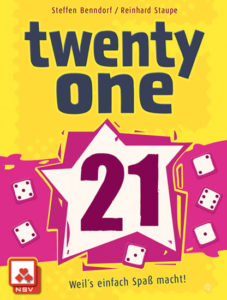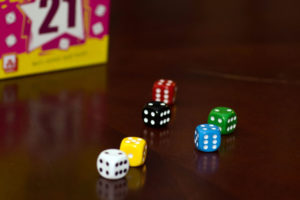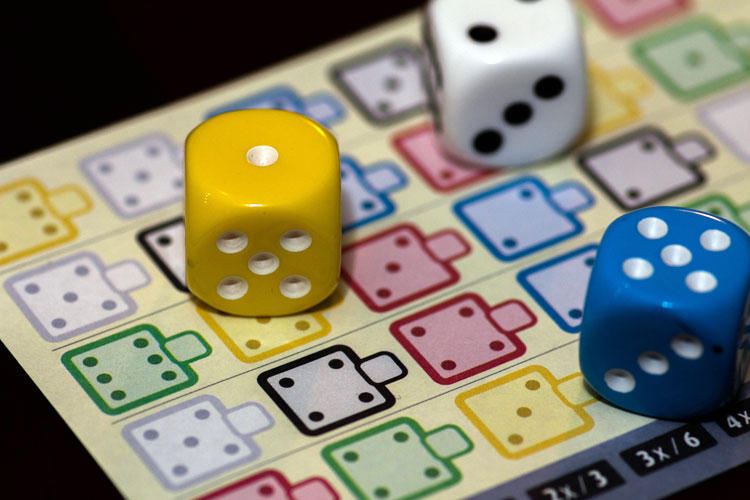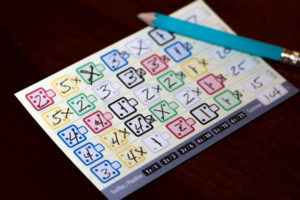 Growing up, my family played a few traditional board games, but most often we played Yahtzee. Especially between my mother and grandmother, there must have been hundreds of pads of Yahtzee scorecards demolished throughout the years.
Growing up, my family played a few traditional board games, but most often we played Yahtzee. Especially between my mother and grandmother, there must have been hundreds of pads of Yahtzee scorecards demolished throughout the years.
In the past few years, a number of games have been released that are often categorized as “roll-and-write” games. Qwixx (review), released in 2013, was nominated for the Spiel des Jahres and really started a boom of similar games.
Today we are looking at Twenty One, co-designed by Qwixx designer Steffen Benndorf. While Yahtzee is the great-great-grandfather of many of these, they have been modernized and updated in a way that makes them more fun to play. Just don’t tell my grandma that I said that.
Twenty One accommodates 2-6 players and plays in about 15 minutes.
Game Overview:
In Twenty One, players will roll six different colored dice and, depending on the result, write scores onto their sheet. Each sheet contains 6 rows and each player can only write a number the top-most incomplete row.
Game Components:
Obviously, Twenty One comes with 6 dice that are all pretty standard 6-sided dice. My particular copy some of the dice had a couple dings in them, but nothing to be too worried about.
One of the things that does differentiate Twenty One from other roll-and-write games are the score sheets. There are six different sheets, so every player is working on a slightly different row, even in a six player game.
That is all that is in the box. Supply your own pens or pencils here folks.
How To Play:

On your turn, you will roll all 6 dice. Any dice showing a “1” must be kept and you can then choose to re-roll all of the other dice or keep your entire roll, but you cannot pick and choose which dice to re-roll.
Then, every player must write down at least one number, if able to. You can only write down a number in the top-most row that is incomplete. Each row shows a die of each of the six colors with a number in it. For instance, a row might show a yellow 6, white 5, blue 4, black 3, green 2, and red 1. You can write down any number rolled if the die of that color is less than or equal to the number on your score sheet. In our example, you could write a 6 in the yellow spot if you happened to roll a yellow 6. If the blue die rolled a 3, you could also legally write that in the blue 4 spot. You just can’t write a number that exceeds the number on the score sheet.
You aren’t limited to just one number though if multiple numbers can be written in your row you can certainly write them all down.
For any die results that match exactly the indicated number, you mark a small box next to it to indicate a “direct hit.” If you can’t legally write down a number in the row you are working on, you must cross off the left-most die on your row. Once the row is complete you total the value and add bonus points based on the number of direct hits. While 1 direct hit in a row will only net you a single point if you nail all 6 of them you get an extra 21 points.
The game ends when any player completes their fifth and final row. All players then total their points and the player with the most points is the winner.

Game Experience:
Let’s get this out of the way: I really like roll-and-write games. Every Christmas party I go to with any type of gift exchange, I’m very likely to be putting a copy of Qwixx in there. I find them to be quick, easy to explain, and give me a bit of nostalgia to my Yahtzee playing days.
Twenty One offers a bit of a different take on this genre of games. The mechanic of being able to take more than one result adds a bit of a racing element to the game. From a strategy standpoint, it gives you the option to take sub-par results, hoping to end the game before everyone else. You can also try to only take the best results and get as many direct hits as possible. This leads to a slower progress through your score sheet, but more bonus points for direct hits.

This also leads to some interesting decisions about how many points you really want to give up. Taking a red 3 result when you have a red 6 on your score sheet is basically giving away three points to gain some efficiency. These decisions do feel like they only change the outcome by a handful of points though. If you happen to have a really good roll that allows you to write 4 or 5 direct hits in a row you will pull way ahead.
There are some roll-and-write elements I’m missing in Twenty One. There isn’t really a push your luck element, you can take the results in any order and you have to fill out every field on the row. While you can write down as many legal results as you want, if you have a roll without any legal moves you can only cross off your left-most empty space. There isn’t an option to take more “misses” to accelerate to the next row that will give you more choices.
I enjoy Twenty One the most as a two player game. This allows you to make some more tactical decisions, especially when it comes to if you should re-roll your initial die roll. If your opponent has a blue 6 option in his row and you happened to roll a blue 6, re-rolling the dice may be your best plan regardless of the how the results fit your sheet. In a game with more players, it is nearly impossible to balance what you need against multiple opponents and I found myself focusing just on what I needed.
Final Thoughts:
Coming from a design team including the designer of Qwixx, Twenty One sure had a lot to live up to. It delivers some new ideas which is nice to see. It is different enough than Qwixx to set itself apart.
My biggest concern with Twenty One is how much luck factors into the game. Obviously a game that hinges on rolling dice I’m not expecting it to be without variance. I don’t mind high variance, especially in short games. However, if you are trying to take a “fast” strategy to write down as many results as you can, even if they aren’t close to the exact hits you are aiming for, a lucky roll for someone else can catch them up in a real hurry.
If you are a fan of roll-and-write type games, Twenty One is an inexpensive game and worth a spot in your collection. Twenty One especially shines as a two player game where you can play close attention to not just your needs but what would be good for you opponent.
If you’d like to pick up a copy of Twenty One, your best chance is to buy it online from Europe.
Final Score: 3 Stars – A clever take on the “roll and write” genre, but not without its flaws.
 Hits:
Hits:
• Adds a slight racing element to a familiar concept
• Inexpensive and provides a great gateway in 15 minutes
• A slightly more tactical experience at 2 players
Misses:
• Less impactful decisions to make than similar games
• Lots of luck needed to win






















